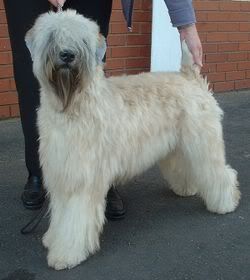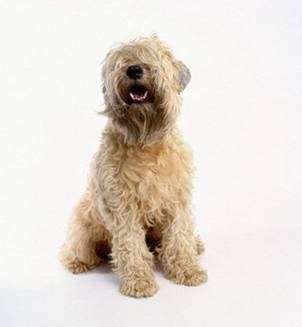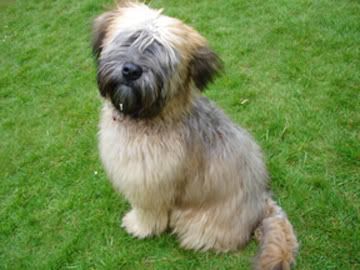Post by charmingnancy on Mar 2, 2009 15:19:50 GMT -5
Soft-Coated Wheaten Terrier
Group: 4- Terriers
Origin: Ireland
Purpose: All-purpose farm dog- herding, watching and guarding livestock, and vermin hunting

Description:
The Soft-Coated Wheaten Terrier is a breed of dog originating in Ireland. There are four coat varieties: Traditional Irish, Heavy Irish, English, and American. They are considered to be hypoallergenic, a trait popular with allergic or asthmatic dog owners. These dogs have hair instead of fur. They are believed to be related to the Kerry Blue Terrier. Today Wheaten terriers also compete in obedience, agility, and tracking, and many are used in animal-assisted therapy as well.
Appearance- Breed Standards:
Coat and Colour: Abundant, single-coated, soft, silky textured, having a gentle wave that is apparent when standing. When the dog moves the coat has a free and flowing character to it. Neither woolly nor wiry, crispy nor cottony, frizzy (tight, crisp curl) nor straight. Colour is any shade of wheaten. Upon close examination occasional red, white or black guard hairs may be found. However, the overall colouring must clearly be wheaten with no evidence of any other colour except on ears and muzzle where blue-grey shading may be present. Puppies under one year may carry deeper colouring and some black tipping. The adolescent under two years may be quite light in colour, but must never be white nor carry grey, other than on ears and muzzle. In both puppies and adolescents, the mature, wavy coat is generally not yet seen. Coat colour and texture do not stabilize until about three years of age and some latitude should be given in young dogs. However, the softer and darker puppy coat should not be preferred over the lighter and slightly harsher adult coat. For show purposes, the coat should be trimmed to present a neat, square terrier outline. Overstyling is to be discouraged and severely penalized.
Head: Well-balanced and moderately long with skull and foreface of equal length and in good proportion to the body. The skull is flat and not too wide. Cheeks are clean; moderate stop. The muzzle is square, powerful, and strong with no suggestion of snipiness. The nose is black and large for the size of the dog. Lips are tight and black. Teeth are strong and white, meeting in a scissor or level bite with scissors preferred. The eyes are dark hazel or brown, medium sized and well protected under a strong brow. Eye rims are black. Coat should fall forward over the eyes. The ears are small to medium in size, breaking level with the skull, and dropping slightly forward, close to the cheeks, pointing to the ground rather than the eye.
Neck: Medium in length and set well upon the shoulders, gently sloping into the back.
Forequarters: The Soft-Coated Wheaten Terrier should have good reach in front. The shoulders should be well laid back with a clean, smooth appearance. The upper arm should be equal in length to the shoulder blade and elbows placed well under the body. The forelegs are straight when viewed from all angles and are well boned and muscled. Dewclaws should be removed. Feet are round and compact with good depth of pad. Dark nails are preferred but tortoiseshell is acceptable. Pads are black.
Body: The body is compact; the chest is deep, but not round. The ribs are well sprung. The back is strong with relatively short coupling. Topline is level.
Hindquarters: The Soft-Coated Wheaten Terrier requires good drive from behind, so requires well-muscled rear assembly. The legs should be well developed with powerful muscles, well-bent stifles, turning neither in nor out. The hocks are well let down and parallel when viewed from behind. Dew claws on rear legs must be removed. Dark nails are preferred but tortoiseshell is acceptable.
Tail: The tail is high set, carried gaily but not over the back. The tail is usually docked so that two-thirds of its original length remains. An undocked tail is allowed.
Gait: The gait is free, graceful and lively, having good reach in front and strong drive from behind, straight action fore and aft.
Faults: The foregoing description is that of the ideal Soft-Coated Wheaten Terrier. Any deviation from the above-described dog must be penalized to the extent of the deviation, keeping in mind the original purpose of the breed.
Major Faults: Yellow eyes; Nose not solid black
Disqualifications: Overshot or undershot mouth; over-aggression.
Size:
Males 18”-19” with the ideal height being 18 - 1/2” (47 cm); for females 17”-18” with the ideal being 17-1/2” (44 cm). Ideal weight for males is 35-40 lbs. (16-18 kg); for females 30-35 lbs.(14-16 kg). Deviations from the ideal should be penalized according to the amount of deviation from the ideal.

Temperament:
Good-tempered, spirited, and game. Affectionate and loyal. Alert and intelligent. Defensive without aggression. He does not start a fight, but should always stand his ground; exhibits less aggressiveness than is sometimes encouraged in other terriers.
Health:
Soft Coated Wheaten Terriers are generally a long lived breed but, as with all other dogs, they can develop health problems. The two most known in the Wheaten are protein losing nephropathy (PLN) and protein losing enteropathy (PLE). PLN is where the dog loses protein from the kidneys; PLE is where the dog loses protein from the intestine. These conditions are eventually fatal. Early detection is key and wheaten owners are recommended to test their dogs at least yearly with the available veterinary tests in their own country (note that not all tests are available in all countries). Neither condition has a known mode of inheritance though there are various research programs, mainly in the United States and the United Kingdom (see health websites for further details). Other wheaten health issues are renal dysplasia, inflammatory bowel disease, Addison’s Disease and cancer. Wheatens can also suffer from food and environmental allergies.
Average Lifespan:
12-14 years.

History:
The actual origin of the Soft Coated Wheaten Terrier cannot be found in printed record. Recurring reference to a terrier soft in coat, wheaten in color, and of a size to fit the Wheaten of today, lends credence to the belief that the history of the Soft Coated Wheaten began long before records were kept and when the challenge of "best dog" was most often settled in a "fists up" confrontation between the owners.
Known for more than 200 years in Ireland, the Soft Coated Wheaten Terrier is believed by some to be an important ancestor of the Kerry Blue. Legend tells us that when the Spanish Armada was sunk off the shores of Ireland, the blue dogs who swam ashore found terriers with a soft wheaten coat waiting to welcome them.
Of necessity these early dogs were bred for their working qualities, with shade of coat or exact measurements of small consideration and no record. As only the brave, strong, and proficient survived and reproduced, nature really set the standard for the original stock of the Soft Coated Wheaten Terrier. Thus has evolved a very attractive, well-made dog of medium size, quick witted, and responsive. The demands of his function required steadiness and discrimination, which have been retained, while preserving the joy in living and the stamina associated with a terrier.
Sponsored by Dr. G.J. Pierse, the Soft Coated Wheaten Terrier was campaigned to registration with the Irish Kennel Club, and on March 17, 1937, a most fitting day for Irish dogs, made its debut in the Irish Kennel Club Championship Show. For many years this breed was required to qualify in both major and minor field trials over rat, rabbit, and badger before attaining championship. Registration with The Kennel Club (England) came in 1943.
In 1962, on St. Patrick's Day - again that most appropriate date - the Soft Coated Wheaten Terrier Club of America was founded when a small group of interested fanciers met in Brooklyn and agreed on a common goal, namely to preserve and protect the Wheaten in the United States and to promote the breed to public interest and American Kennel Club registration. Also present at that meeting were three Wheatens destined to pioneer the breed in the show rings-Holmenocks Gramachree, Gads Hill, and Holmenocks Hallmark, better known as "Irish" (O'Connor), "Liam," and "Maud" (Arnold). Since then, each year has seen substantial gains in registrations, in Club memberships, and in public interest. And each year showing has increased in breed competition and in obedience exhibition.
The Soft Coated Wheaten Terrier was admitted to registration in the American Kennel Club Stud Book on May 1, 1973, and to classification in the Terrier Group at AKC shows October 3, 1973.
Sources:
Wikipedia
Soft-Coated Wheaten Terrier Association of Canada
Just Dog Breeds
AKC
Pictures:
Photobucket
Group: 4- Terriers
Origin: Ireland
Purpose: All-purpose farm dog- herding, watching and guarding livestock, and vermin hunting

Description:
The Soft-Coated Wheaten Terrier is a breed of dog originating in Ireland. There are four coat varieties: Traditional Irish, Heavy Irish, English, and American. They are considered to be hypoallergenic, a trait popular with allergic or asthmatic dog owners. These dogs have hair instead of fur. They are believed to be related to the Kerry Blue Terrier. Today Wheaten terriers also compete in obedience, agility, and tracking, and many are used in animal-assisted therapy as well.
Appearance- Breed Standards:
Coat and Colour: Abundant, single-coated, soft, silky textured, having a gentle wave that is apparent when standing. When the dog moves the coat has a free and flowing character to it. Neither woolly nor wiry, crispy nor cottony, frizzy (tight, crisp curl) nor straight. Colour is any shade of wheaten. Upon close examination occasional red, white or black guard hairs may be found. However, the overall colouring must clearly be wheaten with no evidence of any other colour except on ears and muzzle where blue-grey shading may be present. Puppies under one year may carry deeper colouring and some black tipping. The adolescent under two years may be quite light in colour, but must never be white nor carry grey, other than on ears and muzzle. In both puppies and adolescents, the mature, wavy coat is generally not yet seen. Coat colour and texture do not stabilize until about three years of age and some latitude should be given in young dogs. However, the softer and darker puppy coat should not be preferred over the lighter and slightly harsher adult coat. For show purposes, the coat should be trimmed to present a neat, square terrier outline. Overstyling is to be discouraged and severely penalized.
Head: Well-balanced and moderately long with skull and foreface of equal length and in good proportion to the body. The skull is flat and not too wide. Cheeks are clean; moderate stop. The muzzle is square, powerful, and strong with no suggestion of snipiness. The nose is black and large for the size of the dog. Lips are tight and black. Teeth are strong and white, meeting in a scissor or level bite with scissors preferred. The eyes are dark hazel or brown, medium sized and well protected under a strong brow. Eye rims are black. Coat should fall forward over the eyes. The ears are small to medium in size, breaking level with the skull, and dropping slightly forward, close to the cheeks, pointing to the ground rather than the eye.
Neck: Medium in length and set well upon the shoulders, gently sloping into the back.
Forequarters: The Soft-Coated Wheaten Terrier should have good reach in front. The shoulders should be well laid back with a clean, smooth appearance. The upper arm should be equal in length to the shoulder blade and elbows placed well under the body. The forelegs are straight when viewed from all angles and are well boned and muscled. Dewclaws should be removed. Feet are round and compact with good depth of pad. Dark nails are preferred but tortoiseshell is acceptable. Pads are black.
Body: The body is compact; the chest is deep, but not round. The ribs are well sprung. The back is strong with relatively short coupling. Topline is level.
Hindquarters: The Soft-Coated Wheaten Terrier requires good drive from behind, so requires well-muscled rear assembly. The legs should be well developed with powerful muscles, well-bent stifles, turning neither in nor out. The hocks are well let down and parallel when viewed from behind. Dew claws on rear legs must be removed. Dark nails are preferred but tortoiseshell is acceptable.
Tail: The tail is high set, carried gaily but not over the back. The tail is usually docked so that two-thirds of its original length remains. An undocked tail is allowed.
Gait: The gait is free, graceful and lively, having good reach in front and strong drive from behind, straight action fore and aft.
Faults: The foregoing description is that of the ideal Soft-Coated Wheaten Terrier. Any deviation from the above-described dog must be penalized to the extent of the deviation, keeping in mind the original purpose of the breed.
Major Faults: Yellow eyes; Nose not solid black
Disqualifications: Overshot or undershot mouth; over-aggression.
Size:
Males 18”-19” with the ideal height being 18 - 1/2” (47 cm); for females 17”-18” with the ideal being 17-1/2” (44 cm). Ideal weight for males is 35-40 lbs. (16-18 kg); for females 30-35 lbs.(14-16 kg). Deviations from the ideal should be penalized according to the amount of deviation from the ideal.

Temperament:
Good-tempered, spirited, and game. Affectionate and loyal. Alert and intelligent. Defensive without aggression. He does not start a fight, but should always stand his ground; exhibits less aggressiveness than is sometimes encouraged in other terriers.
Health:
Soft Coated Wheaten Terriers are generally a long lived breed but, as with all other dogs, they can develop health problems. The two most known in the Wheaten are protein losing nephropathy (PLN) and protein losing enteropathy (PLE). PLN is where the dog loses protein from the kidneys; PLE is where the dog loses protein from the intestine. These conditions are eventually fatal. Early detection is key and wheaten owners are recommended to test their dogs at least yearly with the available veterinary tests in their own country (note that not all tests are available in all countries). Neither condition has a known mode of inheritance though there are various research programs, mainly in the United States and the United Kingdom (see health websites for further details). Other wheaten health issues are renal dysplasia, inflammatory bowel disease, Addison’s Disease and cancer. Wheatens can also suffer from food and environmental allergies.
Average Lifespan:
12-14 years.

History:
The actual origin of the Soft Coated Wheaten Terrier cannot be found in printed record. Recurring reference to a terrier soft in coat, wheaten in color, and of a size to fit the Wheaten of today, lends credence to the belief that the history of the Soft Coated Wheaten began long before records were kept and when the challenge of "best dog" was most often settled in a "fists up" confrontation between the owners.
Known for more than 200 years in Ireland, the Soft Coated Wheaten Terrier is believed by some to be an important ancestor of the Kerry Blue. Legend tells us that when the Spanish Armada was sunk off the shores of Ireland, the blue dogs who swam ashore found terriers with a soft wheaten coat waiting to welcome them.
Of necessity these early dogs were bred for their working qualities, with shade of coat or exact measurements of small consideration and no record. As only the brave, strong, and proficient survived and reproduced, nature really set the standard for the original stock of the Soft Coated Wheaten Terrier. Thus has evolved a very attractive, well-made dog of medium size, quick witted, and responsive. The demands of his function required steadiness and discrimination, which have been retained, while preserving the joy in living and the stamina associated with a terrier.
Sponsored by Dr. G.J. Pierse, the Soft Coated Wheaten Terrier was campaigned to registration with the Irish Kennel Club, and on March 17, 1937, a most fitting day for Irish dogs, made its debut in the Irish Kennel Club Championship Show. For many years this breed was required to qualify in both major and minor field trials over rat, rabbit, and badger before attaining championship. Registration with The Kennel Club (England) came in 1943.
In 1962, on St. Patrick's Day - again that most appropriate date - the Soft Coated Wheaten Terrier Club of America was founded when a small group of interested fanciers met in Brooklyn and agreed on a common goal, namely to preserve and protect the Wheaten in the United States and to promote the breed to public interest and American Kennel Club registration. Also present at that meeting were three Wheatens destined to pioneer the breed in the show rings-Holmenocks Gramachree, Gads Hill, and Holmenocks Hallmark, better known as "Irish" (O'Connor), "Liam," and "Maud" (Arnold). Since then, each year has seen substantial gains in registrations, in Club memberships, and in public interest. And each year showing has increased in breed competition and in obedience exhibition.
The Soft Coated Wheaten Terrier was admitted to registration in the American Kennel Club Stud Book on May 1, 1973, and to classification in the Terrier Group at AKC shows October 3, 1973.
Sources:
Wikipedia
Soft-Coated Wheaten Terrier Association of Canada
Just Dog Breeds
AKC
Pictures:
Photobucket

